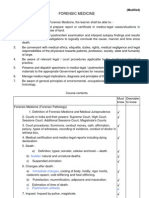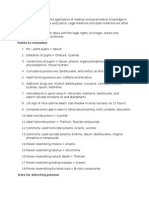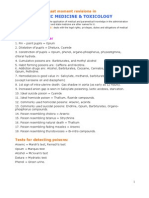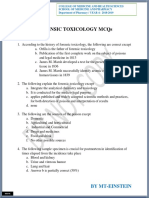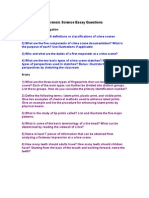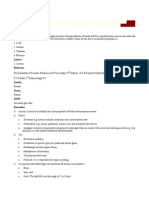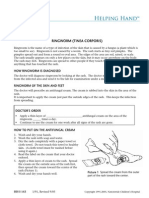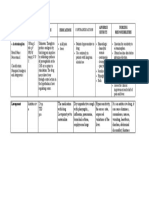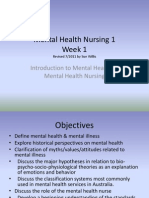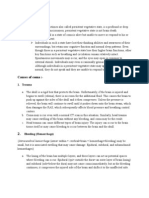Forensic Medicine MCQ
Forensic Medicine MCQ
Uploaded by
Emily KelleyCopyright:
Available Formats
Forensic Medicine MCQ
Forensic Medicine MCQ
Uploaded by
Emily KelleyOriginal Description:
Original Title
Copyright
Available Formats
Share this document
Did you find this document useful?
Is this content inappropriate?
Copyright:
Available Formats
Forensic Medicine MCQ
Forensic Medicine MCQ
Uploaded by
Emily KelleyCopyright:
Available Formats
MBBS SECOND PROFESSIONAL
MODEL QUESTIONS FOR ANNUAL 2009
Forensic Medicine and Toxicology
(Multiple Choice Questions)
Q.1
A surgeon under the effect of Alcohol performed laparotomy operation of a
female patient. During the operation she was quite wreck less. As a result of
this death of the patient occurred. The surgeon is guilty of:
a) Civil medical negligence.
b) Criminal medical negligence.
c) Ethical malpraxis.
d) Therapeutic misadventure.
e) Contributory medical negligence.
Q.2
Death of a person occurred when he was hit by revolver bullet. On
postmortem examination there was deposit of soot around the entry
wound. Tattooing was spread over a large area. The skin was not burnt and
hair was not singed. The approximate distance of fire is:
a) Firm contact.
b) 6 Inches.
c) 1-2 feet.
d) 6-8 feet.
e) 15-20 feet.
Q.3
A fully conscious person reported to the emergency room of a Tertiary care
hospital. He sustained injury on the head during a fight. There was a boggy
swelling measuring 6 x 4cm on the right parietal area. On X-ray
examination there was fracture of parietal bone without displacement of
the ends. The nature of injury is:
a) Shajjah Khafifah.
b) Shajjah munaqillah.
c) Shajjah Damigah.
d) Shajjah Hashimah.
e) Shajjah Ammah.
Q.4
The dead body is lying on autopsy table. There is leathery, fine, tenacious,
persistent froth at mouth and nostrils. The death is due to:
a) Opium poisoning.
b) Barbiturate poisoning.
c) Throttling.
d) Drowning.
e) Traumatic Asphyxia.
Q.5
Death of a person occurred due to multiple bullets hitting the head. The
skull and brain are shattered. Brain matter is coming out. There is no injury
on any other part of the body for determination of cause of death. What will
you do?
a) No need to do further examination.
b) Only cranial cavity to be opened.
c) Cranial and chest cavity to be opened.
d) Cranial and abdominal cavity to be opened.
e) Cranial, thoracic and abdominal all to be opened.
Q.6
The drug which is said to reduce appetite and fatigue; is commonly used as
Aphrodisiac; its addicts use it as a Snuff and feel as if insects are creeping
on the skin. The drug is:
a) Cannabis indica.
b) Amphetamine.
c) L.S.D.
d) Cocaine.
e) Aspirin.
Q.7
Salt solution is used as an emetic in cases of poisoning. Its overdosage in a
child can cause damage to:
a) Liver.
b) Heart.
c) Kidney.
d) Brain.
e) Pancreas.
Q.8
A person after ingesting a toxic agent is in a state of Narcosis. The pupils
are contracted. However, on pinching the neck the pupils dilate initially and
slowly return to their original size. The toxic agent is:
a) Barbiturate.
b) Alcohol.
c) Strychnine.
d) Organophosphate.
e) Carbolic acid.
Q.9
The person is being examined for age certification. On examination of X-ray
skull the closure of the saggital suture has started. The approximate age is:
a) 20-25 years.
b) 25-30 years.
c) 30-35 years.
d) 40-45 years.
e) 45-50 years.
Q.10 The findings on the neck area are extensive laceration of neck structure,
tears in sternomastoid and facture dislocation of C 2-C3 vertebrae. These
findings are present in:
a) Accidental hanging.
b) Autoerotic hanging.
c) Incomplete hanging.
d) Suicidal hanging.
e) Judicial hanging.
You might also like
- MCQs in Forensic Medicine and Toxicology 6e by Redd PDFDocument41 pagesMCQs in Forensic Medicine and Toxicology 6e by Redd PDFnabeel78786977% (22)
- MCQ Forensics 1Document29 pagesMCQ Forensics 1Mark Lojero79% (19)
- Forensic Medicine MCQDocument8 pagesForensic Medicine MCQMuhammad Bilal82% (11)
- Midwifery and Obstetrical Nursing McqsDocument10 pagesMidwifery and Obstetrical Nursing McqsPreeti Chouhan100% (8)
- Forensic Medicine Multiple Choice Question BankDocument20 pagesForensic Medicine Multiple Choice Question BankGIST (Gujarat Institute of Science & Technology)57% (14)
- Forensic MCQDocument2 pagesForensic MCQGIST (Gujarat Institute of Science & Technology)75% (4)
- All Forensic MCQsDocument40 pagesAll Forensic MCQshpmon83% (29)
- MCQ ForensicDocument13 pagesMCQ Forensicrn5100% (4)
- Forensics Essay QuestionsDocument2 pagesForensics Essay QuestionsPeter Abikoye100% (3)
- Question Papers Forensic Medicine (PG)Document12 pagesQuestion Papers Forensic Medicine (PG)Kumar KP75% (4)
- Toxicology Q-Bank Updated VersionDocument18 pagesToxicology Q-Bank Updated VersionAhmed Mohamed100% (2)
- (Audiobook) Download Mcqs in Forensic Medicine and Toxicology Full OnlineDocument1 page(Audiobook) Download Mcqs in Forensic Medicine and Toxicology Full OnlineAv Vish67% (6)
- Forensic MCQ 1 PDFDocument13 pagesForensic MCQ 1 PDFMayurdhvajsinh Jadeja100% (4)
- PF McqsDocument31 pagesPF McqsBrother George100% (1)
- Medicine Colloquium Exam - 2010 ADocument36 pagesMedicine Colloquium Exam - 2010 ARasha KhoumassiNo ratings yet
- The ShelfDocument18 pagesThe Shelfsowcowdd100% (5)
- PDF Mcqs in Forensic Medicine and Toxicology 6e by ReddpdfDocument41 pagesPDF Mcqs in Forensic Medicine and Toxicology 6e by ReddpdfIhtisham aliNo ratings yet
- 20 Important MCQDocument8 pages20 Important MCQUsman Ali Akbar100% (1)
- MCQs 1 (37pg)Document38 pagesMCQs 1 (37pg)Muhammad Farhan Khaliq80% (5)
- AIFSET M.SC FS Model Test PaperDocument17 pagesAIFSET M.SC FS Model Test Paperaashuchatt0% (1)
- Forensic MCQs UHSDocument17 pagesForensic MCQs UHSRohama Qubra 279No ratings yet
- Some Model McqsDocument62 pagesSome Model McqsShafiq Ur Rahman100% (1)
- Forensic MedicineDocument6 pagesForensic Medicineapi-1986354867% (3)
- FMT Updates - Recent MCQsDocument3 pagesFMT Updates - Recent MCQsDeeksha BhardwajNo ratings yet
- Final Forensic and Toxicology 8th SemesterDocument9 pagesFinal Forensic and Toxicology 8th SemesterHabib UllahNo ratings yet
- 4137 MCQDocument2 pages4137 MCQRadhika SethuNo ratings yet
- Exam PracticeDocument6 pagesExam PracticeAngus DelaneyNo ratings yet
- Forensic McqsDocument11 pagesForensic McqsAsif JamilNo ratings yet
- Forensic Osce Part III With AnswersDocument11 pagesForensic Osce Part III With AnswersDr-Irfan Habib100% (1)
- Forensic Medicine FINAL REVISIONDocument33 pagesForensic Medicine FINAL REVISIONjspradeepscribd100% (2)
- Forensic Science Question Paper JobschatDocument43 pagesForensic Science Question Paper JobschatTanuj AroraNo ratings yet
- Forensic Medicine MCQDocument13 pagesForensic Medicine MCQvanesa Avramova100% (2)
- Forensic Medicine Toxicology - Last Moment RevisionDocument22 pagesForensic Medicine Toxicology - Last Moment Revisiondrmsk2070100% (1)
- MCQ Test 1Document9 pagesMCQ Test 1Elated TarantulaNo ratings yet
- Forensic Medicine Question PapersDocument13 pagesForensic Medicine Question PapersShane Rodriguez100% (1)
- 200 Pages of MCQs LJDocument96 pages200 Pages of MCQs LJijojo elizabethNo ratings yet
- Department of Oral Medicine & RadiologyDocument68 pagesDepartment of Oral Medicine & RadiologyDr. Tanvi HingankarNo ratings yet
- FORENSIC MEDICINE & TOXICOLOGY 2020-2010 (Regular) Group Wise Question Papers WBUHS © Medical JunctionDocument6 pagesFORENSIC MEDICINE & TOXICOLOGY 2020-2010 (Regular) Group Wise Question Papers WBUHS © Medical JunctionKushal PawadhaNo ratings yet
- LM MCQDocument7 pagesLM MCQnikkosirunoNo ratings yet
- 600+ TOP Forensic Science MCQs and Answers Online Quiz Test 2022Document57 pages600+ TOP Forensic Science MCQs and Answers Online Quiz Test 2022DR PRERNA NATHAWATNo ratings yet
- Forensic QB All - Cbme-1Document19 pagesForensic QB All - Cbme-1labeeba raoof100% (1)
- Forensic MedicineDocument11 pagesForensic MedicineS Balagopal SivaprakasamNo ratings yet
- Medico-Legal Aspects of Injuries: MCQsDocument59 pagesMedico-Legal Aspects of Injuries: MCQsniraj_sd50% (8)
- Ethics MCQsتجميعاتDocument6 pagesEthics MCQsتجميعاتIdeas InfiniteNo ratings yet
- FORENSIC TOXICOLOGY MULTIPLE CHOICE QUESTIONS (MCQs PDFDocument20 pagesFORENSIC TOXICOLOGY MULTIPLE CHOICE QUESTIONS (MCQs PDFMINANI Theobald92% (12)
- Forensic Medicine & Toxicology QBDocument140 pagesForensic Medicine & Toxicology QBShaban YasserNo ratings yet
- Med-Solutions Forensic MedicineDocument140 pagesMed-Solutions Forensic Medicinekamran_zarrar100% (4)
- Forensic Science Essay QuestionsDocument2 pagesForensic Science Essay QuestionsEmily Fields100% (2)
- MCQ BankDocument23 pagesMCQ Bankdrmed100% (3)
- Forensic Notes PDFDocument155 pagesForensic Notes PDFSoni Mahendran100% (3)
- McqsDocument15 pagesMcqsNazaqat FarooqNo ratings yet
- 1-610 NFSU MCQDocument89 pages1-610 NFSU MCQYatrik 10100% (1)
- Faiz An Handbook of Forensic MedicineDocument99 pagesFaiz An Handbook of Forensic MedicineUsama Naushahi100% (2)
- 1 - MCCDDocument26 pages1 - MCCDAnupam SarkarNo ratings yet
- Model Questions For Annual 2009: Forensic Medicine and ToxicologyDocument2 pagesModel Questions For Annual 2009: Forensic Medicine and ToxicologySnitha rk100% (1)
- UNANSWERED Past Plab 1700 McqsDocument260 pagesUNANSWERED Past Plab 1700 McqsHassaan Imtiaz100% (5)
- Mock 5Document56 pagesMock 5heba100% (1)
- PLAB Past Papers - 1700 MCQ's With AnswersDocument263 pagesPLAB Past Papers - 1700 MCQ's With AnswersIfeanyichukwu OgbonnayaNo ratings yet
- Mock 7 PDFDocument58 pagesMock 7 PDFAnonymous YNjSx8GNo ratings yet
- American Board of Family Medicine: TTT SAMPLE TTTDocument72 pagesAmerican Board of Family Medicine: TTT SAMPLE TTTSalah Elbadawy100% (1)
- 25 MCQ 2Document5 pages25 MCQ 288pm7tv7z9No ratings yet
- The Treatment of Alcoholism With Vitamin B: Jonathan E. Prousky, ND, MSCDocument9 pagesThe Treatment of Alcoholism With Vitamin B: Jonathan E. Prousky, ND, MSC286DEVESH MISHRANo ratings yet
- CPD Accredited ActivitiesDocument77 pagesCPD Accredited ActivitiespolianNo ratings yet
- Ringworm (Tinea Corporis) : How Ringworm Is DiagnosedDocument2 pagesRingworm (Tinea Corporis) : How Ringworm Is DiagnosedBudiMulyanaNo ratings yet
- Abnormal Uterine Bleeding in Reproductive-Age Women - Terminology and PALM-COEIN Etiology Classification - UpToDateDocument46 pagesAbnormal Uterine Bleeding in Reproductive-Age Women - Terminology and PALM-COEIN Etiology Classification - UpToDateCristinaCaprosNo ratings yet
- Skin and Eye Infection MicpDocument17 pagesSkin and Eye Infection MicpMarc Kevin MendozaNo ratings yet
- Unit 20 Medical Physics Techniques CompleteDocument7 pagesUnit 20 Medical Physics Techniques CompleteSum Wing Samuel SoNo ratings yet
- OR Director SBFR Check ListDocument2 pagesOR Director SBFR Check ListShime GezuNo ratings yet
- Craniofacial Microsomia 2019Document15 pagesCraniofacial Microsomia 2019Varun bharathiNo ratings yet
- Animal Testing ProsDocument6 pagesAnimal Testing ProsShalini KanganNo ratings yet
- Ebj ArticleDocument5 pagesEbj ArticleAllyana de JesusNo ratings yet
- Application HiroshimaDocument49 pagesApplication Hiroshimagiyan77No ratings yet
- 15 Series TNC-1Document25 pages15 Series TNC-1Poonam Yadav roll no.53No ratings yet
- Penetrating Abdominal Trauma (Stab Wound)Document1 pagePenetrating Abdominal Trauma (Stab Wound)P BNo ratings yet
- Infection Control Apparel: Peace of Mind in All You DoDocument24 pagesInfection Control Apparel: Peace of Mind in All You DoTony JacobNo ratings yet
- AppendicitisDocument32 pagesAppendicitisEarlKristofferdeGuia100% (3)
- LRR NEET PG Pathology Part 1Document82 pagesLRR NEET PG Pathology Part 1pdivyashreerajNo ratings yet
- NEONATAL APNOEA SMNRDocument18 pagesNEONATAL APNOEA SMNRAswathy RC100% (1)
- EncephalitisDocument30 pagesEncephalitisHITIPHYSIO100% (1)
- CHN Rle Midterm Exam ReviewerDocument3 pagesCHN Rle Midterm Exam Reviewercassy Sadie100% (1)
- Drug NameDocument1 pageDrug NameSherlyn KirisakiNo ratings yet
- List of Anesthetic, Analgesic and Tranquilizer Drugs Veterinary)Document25 pagesList of Anesthetic, Analgesic and Tranquilizer Drugs Veterinary)drbadman77100% (2)
- DR Adedayo OSHOLOWU - Clinical Director - Special Olympics - NIGERIADocument3 pagesDR Adedayo OSHOLOWU - Clinical Director - Special Olympics - NIGERIAAdedayo OsholowuNo ratings yet
- Bloq InfraDocument6 pagesBloq InfraMaría Alejandra García QNo ratings yet
- Exercises: Physical Fitness Test Individual FormDocument1 pageExercises: Physical Fitness Test Individual FormHazelle SagaoNo ratings yet
- MohDocument45 pagesMohDrAnand Nair NNo ratings yet
- Introduction To Mental Health & Mental Health NursingDocument21 pagesIntroduction To Mental Health & Mental Health NursingKhanh LeNo ratings yet
- Floseal Hemostatic Matrix 5 mL/10 ML: Baxter Confidential Internal Use OnlyDocument7 pagesFloseal Hemostatic Matrix 5 mL/10 ML: Baxter Confidential Internal Use OnlyEsha TwinkleNo ratings yet
- Coma StimulationDocument18 pagesComa StimulationDarshika Vyas Mohan88% (17)
- Tugas 1 Present TenseDocument3 pagesTugas 1 Present TenseMas Eja Agip PramamaNo ratings yet






















